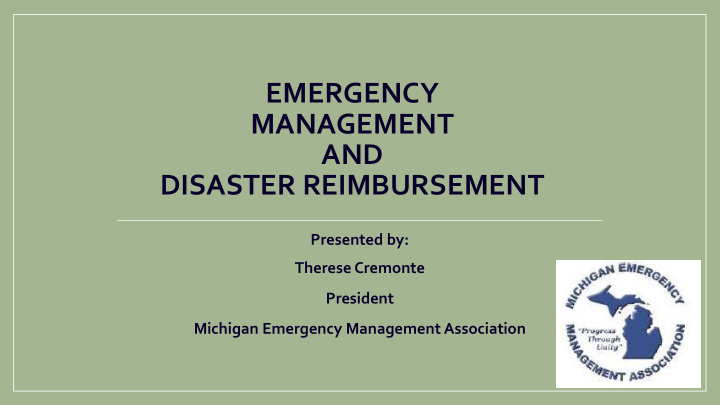



EMERGENCY MANAGEMENT AND DISASTER REIMBURSEMENT Presented by: Therese Cremonte President Michigan Emergency Management Association
WHAT IS AN EMERGENCY OR DISASTER ??
ANYTHING That disrupts the normal, every day activities of a community • SNOW STORMS / ICE STORMS • FLOODS / DROUGHTS • TORNADOS / HURICANES / WIND STORMS • LARGE FIRES • HAZARDOUS MATERIAL INCIDENTS (Toxic Industrial Chemicals – TICs) • EXTREME VEHICLE ACCIDENTS • LONG TERM POWER DISRUPTIONS • TERRORISM
HOW IT ALL WORKS - FOUR MAJOR PARTS “ The BIG ONE !”
WHAT IS EMERGENCY MANAGEMENT Definition: Emergency management is the managerial function charged with creating the 1. framework within which communities reduce vulnerability to hazards and cope with disasters. Emergency Managers are the avenue to connect local, state, and federal partners 2. during a disaster / emergency. They are the key for local government to unlock resources or funding as applicable. Mission: Emergency management protects communities by coordinating and integrating all activities necessary to build, sustain, and improve the capability to mitigate against, prepare for, respond to, and recover from threatened or actual natural disasters, acts of terrorism, or other man-made disasters. BOTTOM LINE : Make communities more resilient and to support efficient recovery after an event .
WHAT GOVERNS EMERGENCY MANAGEMENT? ACT 390 OF 1976 – State of MI ▪ Makes the Governor the responsible for coping with disasters or emergencies ▪ Makes the Director of the Michigan State Police the State Director of Emergency Management, answering directly to the Governor ▪ Directs the creation of the Emergency Management Division within the Michigan State Police ▪ Defines what events may be a “disaster” ▪ Requires the appointment of an Emergency Management Coordinator in every county, local jurisdiction over 25,000 residents, and colleges / universities with an average population of faculty, staff, & students over 25,000. ▪ Outlines the powers of the Governor, county, municipality. ▪ Explains assessments and declarations
WHAT GOVERNS EMERGENCY MANAGEMENT? SECTION 19 - Amended 2018 Act 264: • Section within Act 390 that outlines Michigan’s Disaster and Emergency Contingency fund • Outlines grants and financial assistance that can be provided to eligible counties / jurisdictions when an “extraordinary burden” has been placed on available resources ▪ Must demonstrate a exhaustion of local effort (resources) ▪ Utilizing the current & approved Emergency Operations Plan • Funding will not exceed following amounts or 10% of annual budget, or which ever is less ▪ Population under 25,000 – up to $250,000.00 ▪ Population more than 25,000 but less than 75,000 – up t0 $500,000.00 ▪ Population over 75,000 – up to $1,000,000.00
WHAT GOVERNS EMERGENCY MANAGEMENT? STAFFORD ACT 1988 - Federal: • Governor must certify in writing the disaster or emergency has overwhelmed state & local resources • Authorizes the President to make a Presidential Declaration and send in federal resources – these take many forms • Several levels of financial assistance. ▪ Public Assistance requires a 25% match ▪ Individual Assistance, no match ▪ Small Business Loans – most common type of assistance
What are “RESOURCES” ❖ Personnel ❖ Technology ❖ Communications ❖ Equipment ❖ Sheltering ❖ Logistical ❖ Funding
RESOURCE & FUNDING FLOW ALL disasters / emergencies start LOCAL EXCEPTIONS (not the rule) • 1995 Oklahoma Federal Building Bombing • 2001 Pentagon Terror Attack • 2020 COVID 19 Pandemic Once LOCAL RESOURCES are exhausted and a local declaration made ……. The STATE of Michigan may provide resources if declaration is approved by Governor and resources are available ** If state resources are exhausted** The Governor may make a state declaration to request FEDERAL resources …… •
❖ Know & support your Emergency Manager ❖ Assure your Emergency Operations Plan is current ❖ Collaborate with local jurisdiction leaders in your county ❖ Plan ahead to sustain your community ❖ Educate your citizens in preparedness so they can self-support ❖ Support your Non-Government Organizations (I.E. charities & shelters) ❖ Support public & governmental communications ❖ DOCUMENT: expenses, materials, personnel, donations, etc.
Qu Quest estions ions ?? ???
Recommend
More recommend